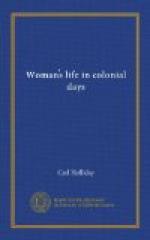The dinners and balls seem to have been expensive enough, but another demand for expenditure, especially in items of dress, arose from the constantly increasing popularity of the theatre. In Philadelphia the first regular theatre season began in 1754, and from this time forth the stage seems to have filled an important part in the activities of society. We find that Washington attended such performances at the early South Street Theatre, and was especially pleased with a comedy called The Young Quaker; or the Fair Philadelphian by O’Keefe, a sketch that was followed by a pantomimic ballet, a musical piece called The Children in the Wood, a recitation of Goldsmith’s Epilogue in the character of Harlequin, and a “grand finale” by some adventuresome actor who made a leap through a barrel of fire! Truly vaudeville began early in America.
Mrs. Adams from staid old Massachusetts, where theatrical performances were not received cordially for many a year, wrote from Philadelphia in 1791: “The managers of the theatre have been very polite to me and my family. I have been to one play, and here again we have been treated with much politeness. The actors came and informed us that a box was prepared for us.... The house is equal to most of the theatres we meet with out of France.... The actors did their best; the ’School for Scandal’ was the play. I missed the divine Farran, but upon the whole it was very well performed.”
The first theatrical performance given in New York is said to have been acted in a barn by English officers and shocked beyond all measure the honest Dutch citizens whose lives hitherto had gone along so peacefully without such ungodly spectacles. As Humphreys writes in her Catherine Schuyler, “Great was the scandal in the church and among the burghers. Their indictment was searching.... Moreover, they painted their faces which was against God and nature.... They had degraded manhood by assuming female habits."[226]
But in most sections of the Middle Colonies, as well as in Virginia and South Carolina, the colonists took very readily to the theatre, and in both Pennsylvania and Virginia, where the curtain generally rose at six o’clock, such crowds attended that the fashionable folk commonly sent their negroes ahead to hold the seats against all comers. Williamsburg, Virginia, had a good play house as early as 1716; Charleston just a little later, and Annapolis had regular performances in 1752. Baltimore first opened the theatre in 1782, and did the thing “in the fine style,” by presenting Shakespeare’s King Richard. Society doubtless tingled with excitement when that first theatrical notice appeared in the Baltimore papers.
“THE NEW THEATRE IN BALTIMORE
Will Open, This Evening, being the 15th of January ...
With an HISTORICAL TRAGEDY, CALLED
KING RICHARD III
* * * * *




